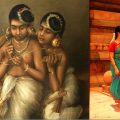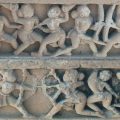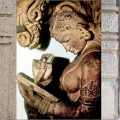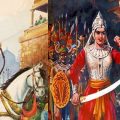4 Women Role Models from Ancient India: From Rishikas to Householders
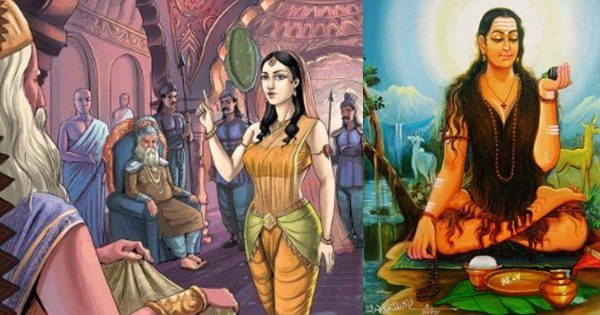
Women’s day is a day of celebration of womanhood and of showing respect, love and appreciation towards all women. Western feminism has had its own trajectory, in its efforts to be free from Christian misogyny, along with the Biblical exhortation that “woman shall not have authority over man.” Even the feminism arising from Western modernity struggles with privileging traditional masculine roles and measuring the success of women by that sole yardstick and by their commercial objectification. On the other hand, in the Indian context, women were always honored for who they were, for their wisdom, courage, beauty, and sacrifice. There have always been women exemplars and role models. From Sita, Draupadi, Kunti or Mandodari in the Itihasas and Vedic Rishikas like Gargi and Maitreyi to Kshatriya women like Lakshmibai and Rudhramadevi or saints like Meera and Andal. They all represent various facets of womanhood and can serve as inspiration for generations of women to follow their inner calling towards self-actualization.
Towards this end, in the present article, we would look into life accounts of four women, who are less known, but whose lives are nevertheless as inspiring and instructive as those listed above. All the four women whose accounts are included were fiercely independent, freely pursued their own paths to self-actualization and never swayed away from their swadharma. While two of them were renunciates, the other two were householders.
Let us now look briefly into the life accounts of these four women and what we may learn from them.
Sulabha
The account of Sulabha, appears in the Shanti Parva of Mahabharata. She was a learned scholar, Rishika, single woman and a renunciate. Mahabharata describes her as a woman belonging to the mendicant order, who practiced the duties of Yoga and wandered over the whole Earth. The Saulabha Shakha of Rigveda Samhita is attributed to her. She is also listed in the Kaushtiki Brahmana among the list of teachers, to whom salutations must be offered. While Sulabha was wandering from one place to another, as was the routine of renunciates, she heard from fellow renunciates that the King Janaka of Mithila was very devoted to the path of emancipation and had become emancipated even while living the life of a householder. Desiring to personally interview Janaka and test whether he had indeed become emancipated, Sulabha, traveled to Mithila. Using her Yogic powers, she transformed herself into a faultlessly beautiful young woman and presented herself to the King as a young renunciate. After receiving respectful welcome from Janaka, wishing to now test whether he had indeed attained emancipation, Sulabha, again by her yogic power entered the understanding of the king using her own understanding.
Immediately grasping her presence inside his mind, Janaka became agitated. Interrupting her, he asked “O holy lady, to what course of conduct are you devoted? Whose are you? From where have you come?” Janaka then told her: “O lady of the mendicant order, I cherish an affection for you. But that should not prevent me from telling you that your behaviour does not correspond with the practices of the mode of life, which you have chosen for yourself.” He continued that he doubts whether she had even subdued her senses, after all she was so delicate, shapely and beautiful. He then told her that by entering his understanding with hers, by uniting with him through the mind, Sulabha had committed many faults and was unfit to be a renunciate.
Though rebuked in such harsh words, Sulabha, did not become embarrassed and replied to Janaka calmly. After briefly explaining the verbal faults and faults of judgment that may occur in speech, she directly addressed the Janaka’s question of “who she is and whose she is”. After stressing how primal elements were same in all objects and beings, she said “I, you, O monarch, and all others that are endued with body are the result of that Prakriti”. She then questioned him: “As you see your body in your own body and your soul in your own soul, why is it that you do not see your own body and your own soul in the bodies and souls of others? If it is true that you see an identity with yourself and others, why then did you ask me, who am I and whose am I? If it is true that you, o king, have been freed from the knowledge of duality that (erroneously) says–this is mine and this other is not mine,–then what use is there with such questions as Who are you, whose are you and from where you came? What indications of Emancipation can be said to occur in that king who acts as others act towards enemies and allies and neutrals and in victory and truce and war? What indications of Emancipation occur in him who does not know the true nature of the aggregate of three as manifested in seven ways in all acts and who, on that account, is attached to that aggregate of three? What indications of Emancipation exist in him who fails to cast an equal eye on the agreeable, on the weak, and the strong? Unworthy as thou art of it, your pretense of Emancipation should be put down by your counselors!”
Then addressing Janaka’s allegation about her committing fault by uniting with him in the mind, which Janaka compares to physical union, Sulabha asked: “When I have no real connection with even my body, how then can I be said to have any contact with the bodies of others?….O king of Mithila, I am staying in you without touching you at all even like a drop of water on a lotus leaf that stays on it without drenching it in the least. Notwithstanding instructions of Panchasikha (Janaka’s Guru) of the mendicant order, your knowledge has become abstracted from the sensual objects to which it relates. You have, it is plain, fallen off from the domestic mode of life but you have not yet attained to Emancipation that is so difficult to arrive at. You stay between the two, pretending that you have reached the goal of Emancipation.” She continued: “Only those that regard the soul to be identical with the body, and that think the several orders and modes of life to be really different from one another, are open to the error of supposing an intermingling to be possible. My body is different from yours. But my soul is not different from your soul. When I am able to realise this, I have not the slightest doubt that my understanding is really not staying in you, though I have entered into you by Yoga. A pot is borne in the hand. In the pot is milk. On the milk is a fly. Though the hand and pot, the pot and milk, and the milk and the fly, exist together, yet are they all distinct from each other. The pot does not partake the nature of the milk. Nor does the milk partake the nature of the fly. The condition of each is dependent on itself, and can never be altered by the condition of that other with which it may temporarily exist. After this manner, varna and practices, though they may exist together with and in a person that is emancipate, do not really attach to him. How then can an intermingling of orders be possible in consequence of this union of myself with you?” Having listened to these words from Sulabha, and perhaps realizing his own fault, King Janaka stayed silent.
Sulabha is one of the most interesting persons in the Hindu tradition. She was a realized woman, who was fiercely independent and acted out of conviction. Regarding her being a renunciate, she boldly says that since, “no husband could be obtained for me that would be fit for me”, she chose to follow the path of renunciation. Thus, following her inner calling, she chose renunciation out of free will. Her renunciation, her arrival at Mithila, her conversation with King Janaka, all show her as an extremely confident woman who was deeply knowledgeable with a strong inner conviction. Her responses to Janaka’s query about “whose she is”, show how even a person like Janaka, who was widely known for his wisdom was still incomplete in his understanding. Her teachings to King Janaka, which are in sync with teachings in other Hindu scriptures, show how contrary to modern assertions that much of Hindu texts were written by men and hence have a gender bias, the texts have no gender bias and their diverse teachings are only an outcome of the necessity to address the needs of people with different competencies.
Now, let us look into another illustrious woman, but this time a householder: Queen Madalasa.
The account of Madalasa appears in Markandeya Purana. She was a Gandharva queen who was won over by King Kuvalayaswa after he slayed many Daityas, who were troubling her. She was a Brahmavadini, a Jivanmukta, who despite being liberated chose to lead a householder life. Her life account depicts the ideal of motherhood and how a mother can be a Guru, guide, and mentor to her children and lead them to the ultimate goal of Moksha.
After marriage, Madalasa gave birth to Vikranta, her first son. From childhood she used to impart teachings on dispassion, self-control, the illusive nature of the world, and on the true nature of the self to her child. Markandeya Purana says: “As her son, shorn of attachment, grew up day by day the queen taught him knowledge of self in the shape of ministering to him in sickness etc. As he duly acquired strength and the heart of his father he attained to self-knowledge by his mother’s words. Having been thus instructed from his very birth the wise (son), with his mind shorn of attachments, did not think of entering the life of the house-holder.” In fact, the teachings of Madalasa began right at infancy in the form of lullabies. Here is a sample of the lullabies she used to sing to her infant son, as mentioned in the Markandeya Purana:
“Thou art pure, O child, and without a name. It is by imagination that a name has been given to thee. This thy body, composed of five elements, is not thine. Nor dost thou belong to it. Wherefore dost thou weep?”
“Or perhaps thou dost not weep – This is a self-produced sound coming out through the king’s son. Various qualities, good or bad, relating to the elements, have been attributed to thy organs.”
“In this world, beings, extremely feeble, acquire their growth by help of the elements, and taking meats and drinks; but thou hast no growth or decay.”
“On earth is the conveyance, in the conveyance is the body – and in the body is placed another person. The sense of this is mine does not exist there as it is in the body. Oh fie on the infatuation.”
As a result of such teachings being imparted from childhood, Vikranta grew up with extreme dispassion and renounced the life early without entering the householder stage. The same happened with Madalasa’s second son Subahu and third son Shatrumardana. They also renounced the world and became Sannyasins as soon as they reached adulthood.
When Madalasa gave birth to her fourth son Alarka, Kuvalayaswa requested his wife not to impart the knowledge of the Self and instead impart to him the teachings of Dharma, so that Alarka could rule the kingdom after him. Heeding to her husband’s request, Madalasa instructed the child Alarka by way of consoling him in the following manner: “Grow, my son, and gratify my lord with acts. Be you for the good of friends and destruction of the enemies. Blessed are you, O my son, who, freed from your enemies, will govern the earth for a long time. May all enjoy happiness by your rule, and may you, by acquiring religious merit, be immortal. You should attentively gratify the Brahmanas at every Parva, satisfy the desires of your friends, should think of doing good to others and abstain from violating others’ wives. Celebrating various sacrifices you should gratify the celestials, with profuse wealth you should please the twice-born; you should satisfy the women with numberless articles of enjoyment and your enemies with fight, O hero. In boyhood satisfy your friends, in youth your worshipped relatives by obeying their commands, in manhood the women having ornaments of noble ancestry and in old age, O my son, in the forest, the rangers thereof. While ruling you should gratify your friends, protect the pious, celebrate sacrifices, destroy the wicked and enemies in battle on behalf of kine and Brahmanas and then meet with death.” The Purana further elaborates various teachings with respect to Pravritti marga or householder life that Madalasa gave her son. As a result of such teachings, Alarka grew into being a great king.
Madalasa is another important woman exemplar in the Hindu tradition. She single handedly led her sons to dispassion and self-realization. She was a Brahmavadini, who chose to enter the householder stage of life. She was independent, shared a very loving relationship with her husband, and was an ideal of motherhood. Though Alarka became a king, later after ruling prosperously for many years, renounced the world, which was again a natural outcome of the teachings of his mother. Apart from imparting Brahma-jnana to her children, Madalasa also had many philosophical discussions with her husband and instructed him in spiritual life. Thus, Madalasa ensured the spiritual emancipation of her entire family. Another interesting point to note is, the teachings of Madalasa to Alarka regarding householder life are in complete sync with teachings on the same topics in the various smritis and dharmashastras, again highlighting the fact that the allegation of gender bias in smritis and dharmashastras is just that: an allegation, without any basis in truth.
Bhamati
The third woman icon we look into in this article is: Bhamati, the illustrious wife of the famous Vachaspati Mishra, who lived in the 10th century CE. The tradition has it that Vachaspati Mishra was none other than Sri Sureshwaracharya, the disciple of Adi Shankaracharya, who took rebirth with the sole purpose of writing a commentary on Brahmasutra Bhashya of Adi Shankaracharya. Be it as it may, Vachaspati Mishra was born in the Mithili region and from very early in life he was intent upon writing a commentary on Brahmasutra Bhashya. In fact, he had no other worldly desire except writing this commentary and had taken a vow quite early in life that he would renounce the world after finishing his commentary. Vachaspati’s mother had brought him up single handedly and when she became old, she wished for her son to marry. But, when she brought a marriage proposal of a girl from neighboring village, Vachaspati clearly conveyed to the girl and her father that his sole goal in life was to write the commentary as a service to humanity and that he had taken a vow to become a renunciate after fulfilling this purpose. He further told them that he highly doubts whether he would be able to do justice to householder life, since his mind continuously dwelled on Brahmasutra. Hearing this, the bride’s father was obviously apprehensive of the marriage proposal, but the girl insisted that if she were to marry someone it would be him. The girl was Bhamati and she was soon married to Vachaspati Mishra.
It is believed that the marriage took place on Guru Poornima, which is a very special day dedicated to Guru and Vachaspati had also decided to start his commentary on the same day. As days turned into months, and months into years, Vachaspati kept writing his magnum opus continuously taking only a little rest as and when he could afford to. As Vachaspati single mindedly worked on his life’s magnum opus, Bhamati dedicatedly took care of him and all his spoken and unspoken needs. She ensured day and night that Vachaspati was not inconvenienced in any way, made sure his writing was not interrupted for any reason, and single handedly managed the entire affairs of the house in a smooth and efficient manner.
After a few years, Vachaspati Mishra finally finished his magnum opus. As he got up, he saw that a woman was sitting near him. He could not recognize her at all. Bhamati, noticing her husband’s questioning glare, was supposed to have told him how he had married her many years ago and because of his single-minded devotion and dedication to his work, he had forgotten her. Suddenly remembering something, Vachaspati is believed to have asked her to show her hands. As Bhamati stretched her hands out, Vachaspati immediately recognized them as the hands that served him food each day, the same hands that put on the lamps at night and handled every other work in the house. He was suddenly filled with emotions and was in tears. He expressed his deep gratitude for all that she had done for him since marriage. He expressed immense regret that he was not able to look after her needs or fulfill his duties towards her. He guiltily told her, now that he had completed his work, he had to take Sannyasa as he had vowed, since he had no other desire left for the worldly objects. Bhamati consoled Vachaspati. She told him that she had no regrets and no complaints: she entered this marriage with full knowledge of the journey and she was proud to have been his wife. She told him that she was happy she got the opportunity to assist him and to facilitate him to complete his life’s work; this had brought her immense satisfaction and she desired nothing more from him. Saying so, Bhamati gave her permission for him to enter Sannyasa. Vachaspati was spell bound by Bhamati’s love and dedication towards him, by her self-control and sacrifice. He named his magnum opus “Bhamati” and dedicated his entire life work to his wife, without whose sacrifice, dedication and support, he could not have accomplished his life purpose.
Bhamati’s life account is unique in many ways. She epitomizes one particular aspect of womanhood, of Stri-dharma, of wifehood: saha-dharma-charini. Hinduism perceived marriage or vivaha as a mutual commitment by the couple to pursue Dharma, Artha and Kama i.e. righteous duties, prosperity and desires together. Hence, the wife is described as “saha-dharma-charini”, a person together with whom a man fulfills his duties, his life’s purpose. In other words, it is the wife who facilitates the husband to attain self-actualization and vice versa and both of them together attain happiness and fulfillment. This is exactly what Bhamati did and she did it out of her free will. Bhamati represents extreme strength of character with an iron will and dedication and an equally uncompromising love and sacrifice. She chose to marry Vachaspati despite knowing the difficulties that laid ahead. She did it with single minded resolve because she found her inner calling in facilitating Vachaspati to complete his magnum opus. Thus, in helping him fulfill his life’s purpose, Bhamati attained self-actualization and fulfillment as well.
Mahadevi
Now, let us look at another illustrious woman, this time a naked renunciate, a Shiva devotee by the name “Mahadevi”. She was born in Karnataka and was a prominent Veerashaiva saint in the 12th century CE. Though not much is known about her life account, it is believed that her marriage was arranged with a Jain king Kaushika, but it did not go through as he refused to accept some of her conditions. Mahadevi instead renounced the world and started wandering from one place to another. In one of her Vachanas, she alludes to this episode and mentions how she rejected the mortal love for the immortal love of Chenna Mallikarjuna, who was her Ishta Devata and whom she considered to be her real husband and lover. She says: “Husband inside, lover outside. I can’t manage them both. This world and that other, cannot manage them both.”
After renouncing the world, she wandered for some time in search of a Guru and finally reached the Anubhava Mantapam, where other Veerashaiva saints such as Basavanna and Allama Prabhu used to gather for spiritual discussions. She found her Guru in Allama Prabhu, who further guided her towards self-realization. Mahadevi’s dispassion and Asceticism was so strong that she renounced even the last piece of clothing that she was wearing, and instead chose to roam naked without a care for what society may say. In one of her Vachanas, she alludes to this and says: “People, male and female, blush when a cloth covering their shame comes loose. When the lord of lives, lives drowned without a face in the world, how can you be modest? When all the world is the eye of the lord, onlooking everywhere, what can you cover and conceal?”
Like Sulabha, Mahadevi was an independent woman, who found her inner calling in Sannyasa and in her devotion to Chenna Mallikarjuna. She did not hesitate to break away from the marriage that was arranged, or to discard even the last piece of clothing from her body in her pursuit of Self-actualization. Mahadevi became popularly known as “Akka” or elder sister in recognition of her renunciation, spiritual wisdom, and her role in guiding many others on the spiritual path. Even today, she is a household name in Karnataka as “Akkamahadevi”.
There are two common aspects amongst all the four women we considered above. One, they were all fiercely independent and courageous to follow their inner calling towards their self-actualization despite facing numerous obstacles on their path. Two, they were all deeply rooted in the Hindu Dharmic tradition-Dharma and Adhyatma were not words in a book for them, but a living reality. While Sulabha and Mahadevi renounced the world in response to their inner calling, Madalasa and Bhamati chose the householder life in response to their own inner calling. Each woman, in her own way, excelled at what she did: Madalasa as a mother, Bhamati as a wife, Sulabha as Rishika, or Mahadevi as a devotee; and each woman attained self-actualization.
In the present Indian context, the accounts of these illustrious women’s lives are very important and can serve as guiding light for generations of women. While issues with “body shaming” have now become pop memes, centuries ago, Indian women ascetics like Mahadevi were transcending stereotypes and finding liberation. This liberation required neither the straightjacket of burqas nor the objectification of present-day modernity, but a path rooted in true liberation of the Self from limiting concepts and ideas.
An imported feminism that proposes to wipe diversity out in the name of equality and that projects masculization of women as their self-actualization cannot serve us well. To move towards women’s emancipation in a truer sense, we need to connect back to our roots and to our women exemplars.
Indian tradition upholds the uniqueness of womanhood and recognizes its privileges as well as its responsibilities in the Dharmic scheme of things. It urges each woman to find her own inner calling and attain self-actualization by staying true to her own inner self. It promotes gender harmony that recognizes diversity, instead of artificially constructed utopian equality proposed by the West. While equality promotes sameness and wipes diversity out, harmony seeks to harmonize diversity and facilitate each individual to flourish in her own unique way. While equality, knowingly or unknowingly, results in the masculization of women, harmony encourages each individual to pursue her own paths to self-actualization based on her own inner calling and competency.
Thus, it is high time, we connect back to this tradition, which promotes gender harmony and self-actualization of women.
This article was first published at indiafacts.org.
Featured image courtesy: IndiaFacts.

